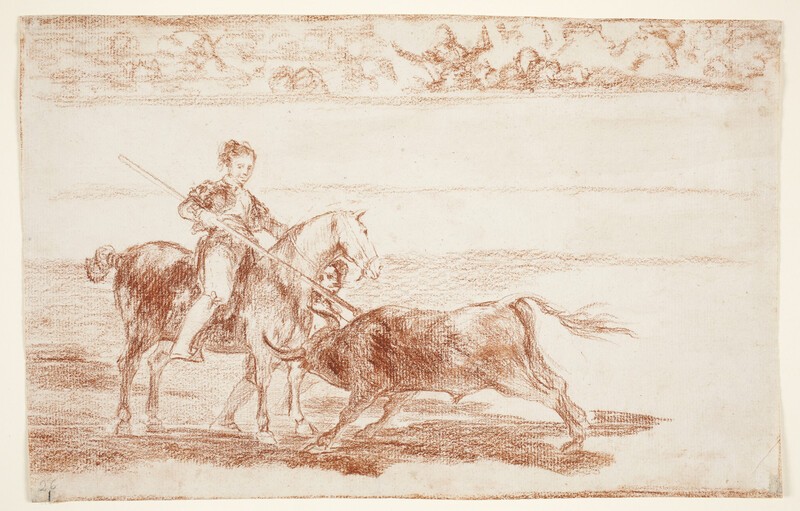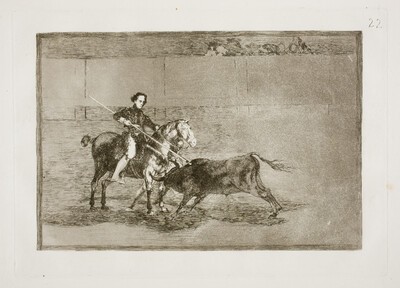- Cronología
- Ca. 1814 - 1816
- Ubicación
- The Prado National Museum. Madrid, Madrid, Spain
- Dimensiones
- 185 x 285 mm
- Técnica y soporte
- Sanguine on laid paper
- Reconocimiento de la autoría de Goya
- Documented work
- Titular
- El Prado National Museum
- Ficha: realización/revisión
- 02 Oct 2021 / 22 Jun 2023
- Inventario
- (D4309)
26 (in pencil, lower left corner)
See How the ancient Spaniards hunted bulls on horseback in the countryside.
This preparatory drawing passed by inheritance in 1828 to Javier Goya, the painter's son, and in 1854 to Mariano Goya y Goicoechea, the artist's grandson. It was subsequently owned by Valentín Carderera (ca. 1861) and Mariano Carderera (1880). In 1886 it was acquired from Mariano Carderera, along with many other drawings by Goya, including almost all the preparatory studies for the Bullfight, by the Directorate General of Public Instruction, and was assigned to the Prado Museum, where it entered on 12 November 1886.
See How the ancient Spaniards hunted bulls on horseback in the countryside.
Preparatory drawing of the print Manly courage of the famous Pajuelera in the one in Zaragoza. Like the print, the preparatory study shows how the famous Pajuelera, mounted on her horse, fights with a bull that she is stinging, while a farmhand holds the bull to prevent it from escaping.
In this case there are few elements different from the later engraving, the most notable being the bullfighter's facial expression, which here is more friendly and less eloquent. The arrangement of her hair is also different, as it is tied back, whereas in the print it is loose. The same is true of the background: here we see the barrier and the bullrings full of spectators - although only suggested by lines outlining bulges - whereas in the engraving Goya reduces the audience to a single group on the right of the composition.
The use of light is similar to that found in the print, with just over the left half of the drawing being illuminated.
-
Madrid2002
-
Santander2017cat. 13
-
1946pp. 177-216, espec. pp. 200-201
-
MadridMuseo del Prado1954n. 175
-
1961pp. 120-127
-
ParísLe Club Français du Livre1963p. 106
-
Vie et ouvre de Francisco de GoyaParísOffice du livre1970p. 278, cat. 1195
-
Barcelona1974p. 16
-
Dibujos de Goya, 2 volsBarcelonaNoguer1975pp. 378-379, cat. 264
-
El mundo de Goya en sus dibujosMadridUrbión1979pp. 200-201
-
Goya y Aragón. Familia, amistades y encargos artísticoscol. Col. Mariano de Pano y RuataZaragozaCaja de Ahorros de la Inmaculada de Aragón1995pp. 227-229
-
MadridMuseo Nacional del Prado2001pp. 78-79
-
SantanderFundación Botín y Museo Nacional del Prado2017pp. 45 y 163, cat. 13

